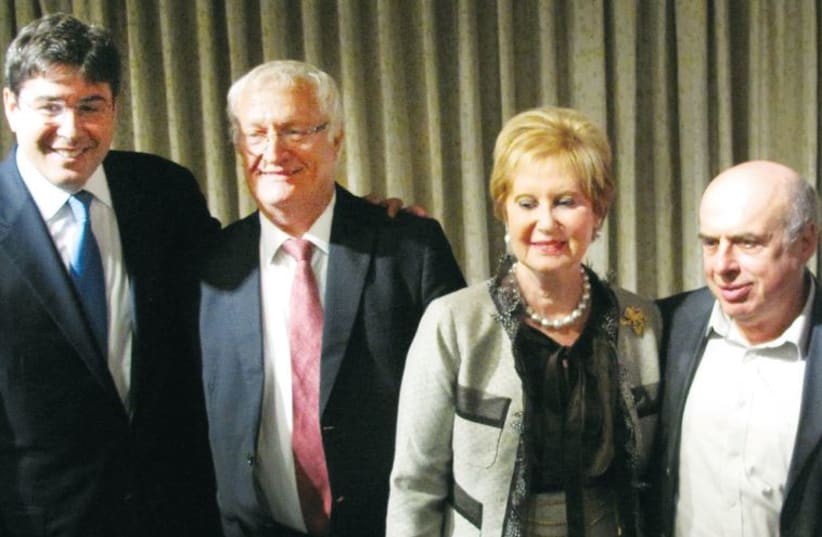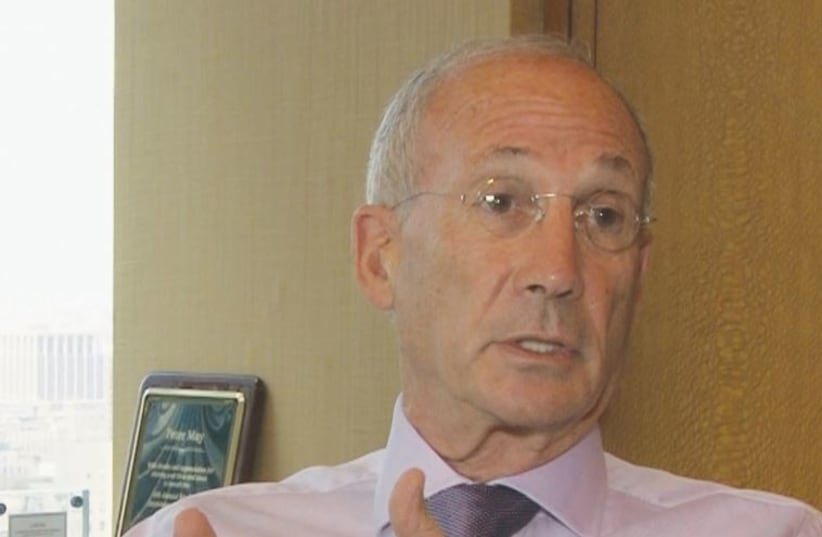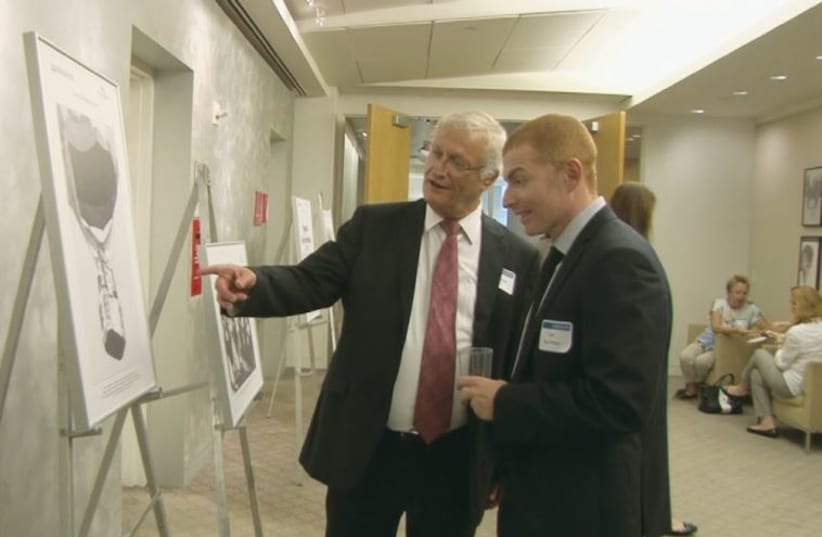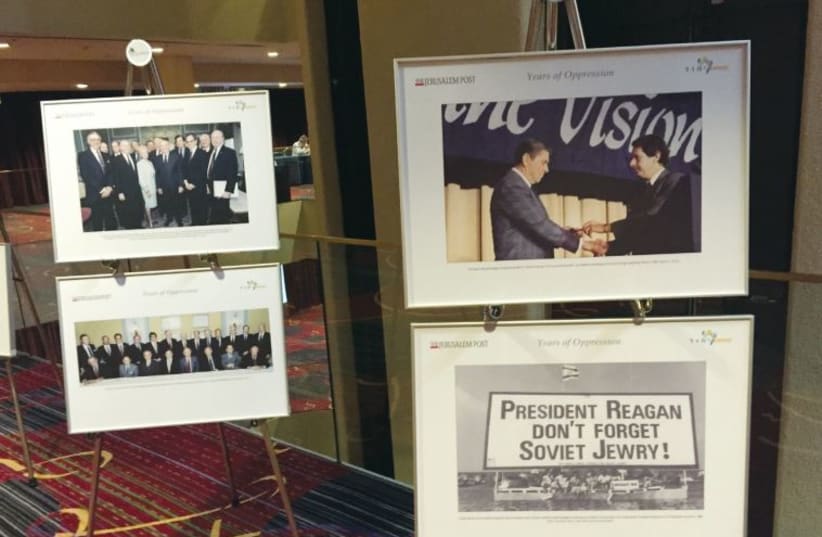




The atmosphere is low-key and marked by a feeling of polite warmth. Men in cool summer jackets sip white wine; women in modest, light summer dresses mingle among the crowd.What is deep here, however, are the pockets. The Jewish patrons in attendance raised $177 million to help liberate some one million of their brothers and sisters in the Soviet Union. But it was not only dollars that they contributed – it was also their hearts.PETER MAY is president of the Trian Investment Company, and chairman of the board of the Mount Sinai Medical Center, the University of Chicago and the New York Philharmonic Orchestra. On his right wrist is the latest-model Apple watch (“My work tool,” he calls it). Twenty-five years ago, he was chairman of Operation Exodus and one of the organizers of the 1987 “Freedom March” on Washington, which brought 250,000 people to the National Mall to protest Soviet leader Mikhail Gorbachev’s visit and declare “Let my people go!” – a call for the Russian Jews stuck behind the Iron Curtain.May is a generous donor whose philanthropic works are self-evident.“It’s easy to write out a check,” he says, “but it is far more important to ensure that the money goes to a worthy cause.”He first visited Israel 31 years ago on the occasion of his parents’ 50th wedding anniversary. When the first of the Soviet Jews landed in the US, he raised millions of dollars to help in their absorption.“Look at this,” he says, pointing to a picture. “Here you see 21 people who, during the course of one breakfast, donated $58m.”Later on, the Jews began to immigrate directly to Israel, and since then, the country has changed completely.Not long ago, May visited Israel with his children and traced the route he had taken with his own parents – except that this time, he says, “I saw a totally different country. From being some sort of miracle, it had been transformed into a modern country.”I ask him what particular scene is engraved in his memory from the days of the barricades.“Seeing people infused with a new sense of hope alighting from the planes,” he tells me.SUSIE STERN is an intense redhead, a totally involved activist. She is soon to become deputy chairwoman of the UJA New York Federation.Her parents visited refuseniks in Russia, and again when they eventually arrived in the US.“This had a great influence on me,” she says.Ever since, she has worn a bracelet belonging to Sonia Malinkova, a Russian woman her own age. For a long time, the two conducted a correspondence, and they became close friends. Stern brought her own children to the Washington march, and when they returned home, her four-year-old son asked, “So is that man [Soviet president Mikhail Gorbachev] going to let them leave?” She answered, “In the end he will.”When Gorbachev indeed let them leave, she took her children to the airport to greet them. Today her children remain active on behalf of the Jews from the former Soviet Union.Asked what the main task is now, she says, “To do everything possible not to lose the next generation.”STEPHEN SOLENDER has spent many complicated days with refuseniks. He first visited them 40 years ago in Moscow. It was during Purim, and he was met with joyful singing in an apartment – but also by a posse of KGB officers waiting at the entrance. When he returned to his hotel room, he found listening devices and a blocked telephone.Solender learned to take precautions. During subsequent visits, he would make calls from a public phone booth and would receive an address and the name of a nearby railway station. He would sit in the last carriage, alight at the station, and wait. When there was no one left on the platform, someone would materialize out of the darkness and conduct him to a meeting of refuseniks. He would give them words of encouragement: “Dear brothers, don’t lose hope, we are working on your behalf.”In New York, he continued to work on their behalf, not only in fund-raising, but also in advancing the Jackson-Vanik Amendment – the 1974 provision that called for suspension of trade with countries that refused their citizens the right of free emigration. He would frequently cross the Iron Curtain. Once he was detained for many hours at Leningrad Airport (today St. Petersburg) because he had brought books in Hebrew with him.But his spirit of determination came through – not only in New York, and not only in regard to the immigration wave of the 1990s. Solender relates that during the Yom Kippur War, at the direction of prime minister Golda Meir, he was involved in flying new immigrants to Israel. At the time, the skies were unsafe, and planes took off only after dark from a transit stop near Rome.At dawn, after the last flight had landed, the seats were dismantled and the planes flew on to the US, returning with medicines and ammunition.Solender, now 77, is determined to keep telling the stories: “I have children and grandchildren. If I keep silent, the stories will be lost.”Asked how he would describe the changes caused by the Russian immigration, he replies, “The fact that [jailed refusenik Natan] Sharansky is now head of the Jewish Agency is just one proof of the colossal contribution of the new immigrants to the state.”ZEESY SCHNUR met Sharansky at the beginning of 1976. She had received her visa to leave when she was in the early stages of pregnancy, just a few days after she had buried her mother. Before she had even completed the seven days of the shiva mourning period, she traveled to Moscow and met Sharansky in the apartment of noted scientist-refusenik Prof. Alexander Lerner. Among the group was a person suspected of spying for the KGB and betraying Sharansky. Lerner was apprehensive that he would also betray Schnur, and took her into another room.“I got the impression that he was a man deeply concerned with universal values,” Schnur says of Sharansky.There are those who have accused him of being an agent of the CIA, but Schnur dismisses this out of hand: “If one had to sleep with the devil to achieve an aim, [Sharansky] would sleep with him. But the suggestion you raise is going too far. If he was an agent of the CIA, then so were we all.”Those days left an indelible mark on her family. Her son is named Eitan Henry in honor of Senator Henry “Scoop” Jackson, co-proposer of the Jackson-Vanik amendment and a major supporter of the struggle for Soviet Jewry.After she ceased work on behalf of Soviet Jews, Schnur opened a public relations company. Her first client was Sharansky. She worked with him when he founded the Yisrael Ba’aliya political party, and later when he served in the government.NATAN AND Avital Sharansky are the Kennedy family of refuseniks, the aristocracy of the Prisoners of Zion.Their drama captured public admiration as none had done before. Their story even made it to Hollywood – some years ago, a script was written, and excerpts were sent to the Sharanskys. However, the couple, who were not afraid of the KGB, were afraid that Hollywood would turn their struggle into a cheap tale of flight, betrayal, money and sex. The script has since been shelved.A halo still accompanies Natan Sharansky in America.The years have made him a master at relating the saga of his survival in prison, with sparks of humor.When a panel at the UJA gathering asks what he was thinking about when he made the epic walk to freedom across the Glienicke Bridge in Berlin, he replies, “I was thinking about keeping my pants up, as I had lost a great deal of weight.”Afterward, he recounts, he was transferred to a car that would not start.“My God,” he recalls thinking, “am I still in Russia?” In Berlin, Avital was waiting for him, and he said to her, “Sorry I’m late.” And that was the first day of the rest of his life – a day that began in a Russian gaol and ended up at the Western Wall.“I must tell you that I did not sleep that night, nor the next, for fear that I would wake up and find myself again back in a Soviet cell,” he says.AN EXHIBITION of photographs on display at the UJA offices provides a tantalizing glimpse into some of the historical moments in the struggle for Soviet Jewry: The Sharanskys hold hands; now-Knesset Speaker Yuli Edelstein and his wife Tania arrive in Israel with their daughter; refusenik Ida Nudel sheds a tear at the Western Wall; a family arrives, their eyes full of questions, but also of hope.The exhibition – a joint initiative of Limmud FSU and The Jerusalem Post – was first displayed along a corridor in the Marriott Hotel during the recent Jerusalem Post Annual Conference. Curator Asher Weill sifted through thousands of photographs in newspaper archives, government sources and private collections before making the final choice of 50 and writing the explanatory texts. Among the private collections were the archives of distinguished photographer Robert A. Cumins, who was present at many of the demonstrations depicted.From the New York Federation’s offices, the traveling exhibition will go on to be shown in Washington and Florida. After that, it will go on display at Limmud FSU conferences in Los Angeles, Toronto, Ukraine, Moldova, Belarus, Jerusalem and Australia.A picture of a hot-air balloon catches the viewer’s attention. It was the summer of 1987, and world leaders, including US president Ronald Reagan and Gorbachev, were in Vienna for the Second Helsinki Conference. Delegations from all corners of the globe had assembled to promote the issues that concerned them. Chaim Chesler, then secretary-general of the Israel Public Council for Soviet Jewry (and now a founder of Limmud FSU), was concerned that the plight of Soviet Jews was going to be pushed to one side. He took with him to Vienna two mothers and two children of refuseniks. In the streets of Vienna, he loaded them onto black tourist carriages with the banner “Let My People Go!” The next day, he had the idea of hiring a hot-air balloon to fly over the palace where the talks were taking place. But there was a problem: Not even a mosquito had permission to fly within a 10-kilometer radius of the palace. Fortunately Givat Shmuel mayor Yaakov Vismonsky, who was part of Chesler’s delegation, had contacts with the Austrian Socialist Party, and permission was somehow obtained.That night, three balloons were hired. The official Israeli delegation did not want attention diverted from its own agenda, and tried to persuade the mothers not to enter the baskets for fear the balloons might crash.Chesler and his colleagues gave them personal guarantees.He, Vismonsky and Yossi Galili – a correspondent for the Itim news agency – each got into a balloon with them. The balloons reached a height of 100 meters, and the “Let My People Go!” banners flew above the palace for all to see. While in the air, the mothers gave interviews to the press, and Chesler seized the opportunity to shout into a microphone, “Let My People Fly!” ANOTHER PICTURE shows a young man taking off a bracelet and giving it to Reagan. That man, Steve Greenberg, was then a UJA activist. In the meantime, he has managed to go bald, but is still a dynamic leader of New York Jewry.In 1983, he took part in the Moriah Process, a group of young people who had gathered at a Dead Sea hotel to consider how to create a dialogue between Israelis and Americans. One of the Israelis was Ron Huldai, then commander of the Hatzerim air force base, and Greenberg’s roommate. A lifelong friendship ensued.Later, when Huldai was principal of the Herzliya Gymnasium in Tel Aviv, Greenberg would come every year to take part in the school’s graduation ceremony.“I saw him hugging the kids and could not believe it was the same tough pilot that I knew from before,” he recalls.While still involved in the Moriah Process, Greenberg served as chairman of the US Council for Soviet Jewry. He had a bracelet with the name of prominent refusenik Yosef Begun engraved on it. When Reagan spoke at the Washington Conference for Soviet Jewry, Greenberg got up and confronted him.“I had intended to give you a map of ancient Palestine,” he said to Reagan, “but instead, please take my bracelet. On your wrist, it will have very much more effect.”In January 1988, summoned by Chesler, Greenberg awaited Begun as the latter descended from the plane that had brought him to Israel. Begun kissed the soil, and someone pointed out Greenberg to him, saying, “This is the man who gave the bracelet to Reagan.” Begun fell on his neck in a warm embrace.